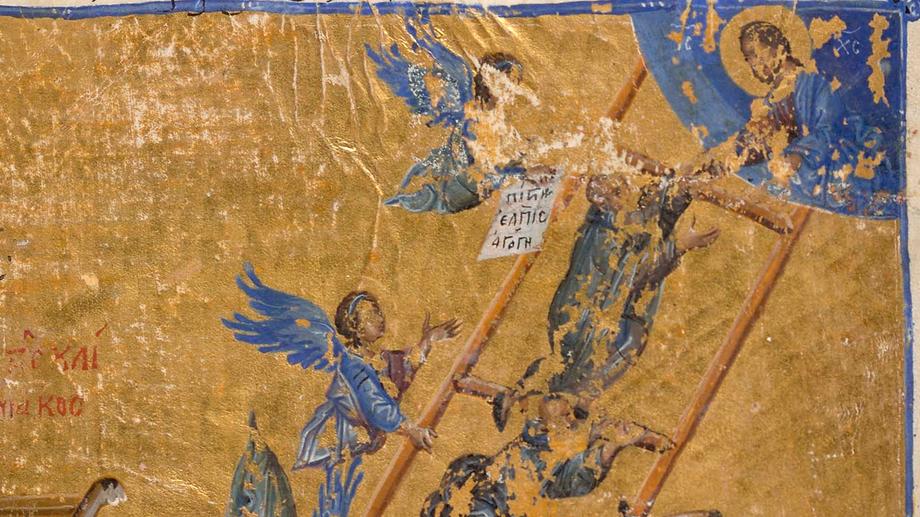Everything old is new again
May 11, 2022
A century ago, amid the political upheaval and humanitarian crises that followed World War I, U-M professor of Latin language and literature Frances Willey Kelsey traveled to Constantinople (now Istanbul). In a shop in the Old City, he purchased the first item of what would become the largest collection of Greek manuscripts in America, which now encompasses more than 100 bound manuscripts and fragments spanning the 4th to the 19th centuries.
Each of the collection's items is unique — all written by hand, some illuminated, and some incorporating elaborate bindings. Taken together, they're a rich source of information about the transmission of Christian texts, manuscript illumination, and historical bookmaking, especially in the late Byzantine Empire.
The curator
Pablo Alvarez, curator in the library's Special Collections Research Center, has been responsible for the Greek manuscripts since arriving at the library in 2010, and he describes it as one of the highlights of his work.
Now, a new exhibit created by Alvarez — available online — celebrates the collection's centenary by shedding light on its history and provenance, and by displaying some of its most beautiful and interesting items.
The exhibit also marks two new publications that will be of long-term service to researchers: volume one of a comprehensive two-volume catalog, and a book that fully describes each of the bindings in the collection.
The catalog
“Soon after I started, I found that the very brief descriptions we had of the Greek manuscripts were written in the early 20th century, with information based on what we knew about ancient Greek at the time,” Alvarez says. A century's worth of research since had greatly advanced knowledge of paleography (the study of old scripts) and codicology (the study of the book as an artifact), and so these descriptions were "woefully obsolete."
That same year, independent scholar Nadezhda Kavrus-Hoffmann made a proposal: she would write a state-of-the-art catalog, one that would help people navigate the collection and identify the items within it that are relevant to their research and teaching. Kavrus-Hoffman, a world-renowned scholar of Byzantine manuscripts, has spent her career analyzing, dating, and cataloging Greek manuscripts, making her "the perfect candidate," according to Alvarez, to take on the project.
It took nearly a decade to publish the first volume of A Catalogue of Greek Manuscripts at the University of Michigan, Ann Arbor (the second is forthcoming), a timespan indicative of the magnitude of the undertaking. "This isn't work that can be done with digitized versions," Alvarez explains. Kavrus-Hoffmann, who lives in New York and Washington, DC, traveled to Ann Arbor three times, and spent many weeks in the Special Collections Research Center analyzing each and every item, page by page, to produce a detailed description.
It was painstaking work.
Also, the costs of publishing such a catalog, which has a very narrow potential buyers' market, could not be easily covered out of the library's normal budget. Fortunately, U-M alum and library supporter Carl D. Winberg, M.D., provided funds for the publication. (Dr. Winberg also funded the publication of the catalog of bindings.)
Alvarez says it's more than worth it. The new catalog not only reflects the latest relevant scholarship; it also corrects inaccurate descriptions and dates, and identifies new texts previously classified as "unknown."
"Readers will access new data that bring these extraordinary manuscripts closer to the time and place in which they were originally produced, read, and transmitted," Alvarez writes in his preface to the book.
The bindings
While the collection catalog focuses on the collection's contents, another new book, Tradition and Individuality: Bindings from the University of Michigan Manuscript Collection by Julia Miller (Legacy Press), considers them as artifacts. The book, which includes contributions from Alvarez and Conservation Technician Kyle Clark, describes each item's binding materials, structure, and decorations.
According to Miller, traditionally bound Greek manuscripts can encompass Coptic, Ethiopian, Syriac, Greek, Georgian, Islamic, Slavic, and Armenian practices, and each unique binding conveys rich information about the history of its production and the context in which it was created.
The opportunities
The collection has always been of great interest to a number of research specialties: biblical scholars are especially interested in the collection's gospels, which date from the 10th century, and compare them to earlier and later versions of the same texts; classical studies students translate and analyze manuscripts in their coursework; and conservators and others who study the history of books and bookmaking use the collection to learn and teach about historical bindings.
The new and more complete descriptions by Kavrus-Hoffman and Miller offer researchers and scholars fresh opportunities to discover more about these extraordinary manuscripts, and about the people and places in which they were created, read, and shared.

Detail from Mich. Ms. 134, Scala Paradisi (The Heavenly Ladder)